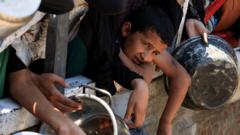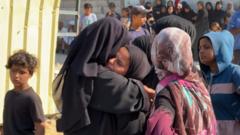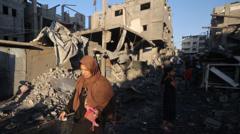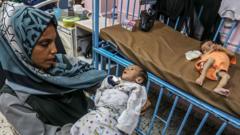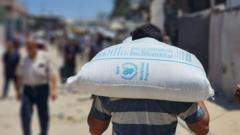The Gaza Humanitarian Foundation's food aid boxes, while providing calories, lack essential nutrients, raising concerns among experts about long-term health repercussions in a region grappling with acute hunger and malnutrition.
The Nutritional Crisis: Examining GHF's Food Aid Boxes in Gaza
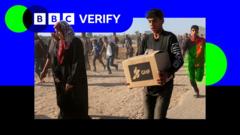
The Nutritional Crisis: Examining GHF's Food Aid Boxes in Gaza
As Gaza faces a severe humanitarian crisis, the contents and nutritional value of food aid boxes from the Gaza Humanitarian Foundation are under scrutiny.
More than two million Palestinians in Gaza are currently battling a dire starvation crisis, with the United Nations reporting an alarming increase in malnutrition-related deaths. Since late May, the Gaza Humanitarian Foundation (GHF), which receives backing from Israel and the United States, claims to have distributed 91 million meals mostly in the form of food boxes.
Although international journalists have been barred from entering Gaza, BBC Verify has reviewed photos shared by the GHF and engaged with aid specialists, many of whom have expressed apprehension regarding the nutritional quality of these food aid boxes.
Videos circulating on social media showcase the food items contained in the boxes. However, the GHF has only recently released images of the contents. These primarily include dried staples that need water and fuel for cooking, such as pasta, chickpeas, lentils, and wheat flour, along with cooking oil, salt, and tahini. The boxes also contain some ready-to-eat snacks like halva bars.
According to the GHF, these boxes contain a combined total of 42,500 calories and can sustain approximately 5.5 people for 3.5 days. Occasionally, substitute items like tea and biscuits are included, along with fresh potatoes and onions, although the organization does not factor these into the nutritional analyses it provides.
Experts are pointing out several flaws in the GHF's food aid. Professor Stuart Gordon from the London School of Economics remarked that while the boxes may offer enough calories, they suffer from severe nutritional deficiencies. He described the food aid basket as a "first aid" approach to combat acute hunger, but cautioned that reliance on such food sources could lead to "hidden hunger" and increased susceptibility to conditions like anemia and scurvy.
Dr. Andrew Seal from University College London echoed these concerns, noting that the boxes are lacking essential nutrients such as calcium, iron, and vitamins C and D, which are critical for vulnerable populations like young children. He emphasized that longer-term reliance on such diets can have serious health consequences.
In contrast to the GHF's approach, agencies such as the United Nations typically distribute food in bulk and offer additional nutrition specifically designed for at-risk populations. The World Food Programme is actively working to ensure that emergency supplies cater to young children and pregnant women.
The GHF has not provided answers to follow-up questions regarding expert nutritional feedback or plans to amend its aid strategies. Furthermore, for those receiving the boxes, the need for water and fuel to prepare the food presents additional challenges, especially given Gaza's ongoing water shortage and fuel crisis.
The United Nations Office of Humanitarian Affairs has reported a rapid escalation in the water crisis, with families resorting to dangerous cooking methods using waste materials. Observations from the World Food Programme indicate that official supplies of cooking gas have ceased, forcing families to buy it on the black market at exorbitantly increased rates, further complicating the situation.
As the humanitarian crisis deepens, UN Secretary-General António Guterres has highlighted the severe shortages of basic supplies in Gaza. Reports indicate that about one in three Gazans are going days without food, while the World Food Programme has pointed out that malnutrition has surged, with 90,000 women and children requiring urgent medical attention.

